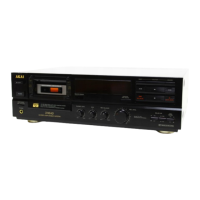
Do you have a question about the Akai GX-65 MKII and is the answer not in the manual?
| Type | 3-head, single compact cassette deck |
|---|---|
| Track System | 4-track, 2-channel stereo |
| Tape Speed | 4.76 cm/s |
| Tape Type | type I, CrO2, Metal |
| Frequency Response (Metal Tape) | 20Hz to 21kHz |
| Signal-to-Noise Ratio | 60 dB |
| Total Harmonic Distortion | 0.8% |
| Heads | 3 |
| Motor | 1 x reel, 1 x capstan |
Safety warning to prevent fire or shock hazard from rain or moisture.
Information on power requirements for electrical appliances in different areas.
Instructions for converting voltage settings on models that support it.
Important steps and precautions before making audio connections.
Detailed steps for connecting the cassette deck to an amplifier.
Step-by-step guide on properly loading a cassette tape into the deck.
Guidance on handling, tape slack, and storage of cassette tapes.
How to use the recording prevention system and defeat tabs.
Explanation of indicators and meters on the fluorescent display.
Details on key buttons for playback, recording, and tape control.
Controls for setting recording level, balance, bias, and noise reduction.
Controls for timer, filter, headphones, and counter.
Preparation steps before starting the recording process.
Step-by-step guide for recording audio onto a cassette tape.
Instructions on how to initiate the recording process.
Methods for stopping the recording process.
Preparation steps before playing back a cassette tape.
Step-by-step guide for playing back audio from a cassette tape.
Instructions on how to stop the playback process.
Setting the recording level using the REC LEVEL control.
Using the REC BALANCE control for stereo balance.
Tips for setting optimal recording input levels.
Comparing source and recorded audio using the monitor function.
Using the auto mute function to create blank spaces.
Simultaneous button press to start recording instantly.
Seamlessly switching from playback to recording.
Using memory functions to stop and play back at specific tape points.
Automatic rewind and playback from a memorized tape counter position.
Automatic playback starting from the tape's beginning.
Setting up the deck for automatic recording using a timer.
Setting up the deck for automatic playback using a timer.
Procedure after timer operations are completed.
Adjusting the BIAS control for optimal recording on different tape types.
Steps for performing bias adjustment using FM inter-station noise.
Final steps after completing the bias adjustment.
Explanation of the MPX filter and its function in FM stereo recording.
Explanation of the digital tape counter and its reset function.
Instructions for connecting and using headphones.
Overview of the Dolby NR system for reducing tape noise.
Comparison of Dolby B and C type noise reduction systems.
Explanation of the double process noise reduction system.
Diagram illustrating the Dolby HX PRO system's operation.
How the deck detects tape type (Normal, CrO2, Metal) via notches.
Explanation of the automatic tape selection mechanism.
List of reference tapes and explanation of the peak level meter.
How to connect decks for tape dubbing.
Importance and steps for cleaning the cassette deck's parts.
Instructions for safely removing and replacing the cassette lid.
Procedure for demagnetizing heads to maintain sound quality.
Tips for cleaning the exterior cabinet of the deck.
Guidance on diagnosing and resolving common issues with the cassette deck.
Detailed technical data and performance metrics of the cassette deck.
Highlights of the cassette deck's advanced functionalities and design.
How to operate the remote control for the cassette deck.
Instructions for installing batteries into the remote control unit.
Important warnings regarding the remote control and its batteries.
